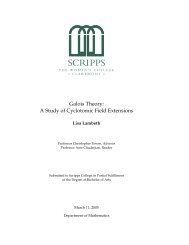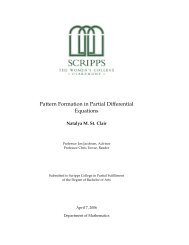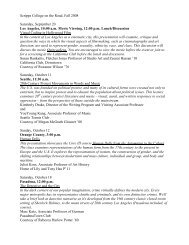Sophie Germain: mathématicienne extraordinaire - Scripps College
Sophie Germain: mathématicienne extraordinaire - Scripps College
Sophie Germain: mathématicienne extraordinaire - Scripps College
Create successful ePaper yourself
Turn your PDF publications into a flip-book with our unique Google optimized e-Paper software.
The First Proof 41<br />
We plug these equations into equation (4.4) to get<br />
x 5 + y 5 = z 5<br />
(p + q) 5 + (p − q) 5 = z 5 .<br />
The binomial theorem says<br />
(p + q) 5 = p 5 + 5p 4 q + 10p 3 q 2 + 10p 2 q 3 + 5pq 4 + q 5<br />
(p − q) 5 = p 5 − 5p 4 q + 10p 3 q 2 − 10p 2 q 3 + 5pq 4 − q 5<br />
So<br />
z 5 = (p + q) 5 + (p − q) 5 = 2p(p 4 + 10p 2 q 2 + 5q 4 ). (4.5)<br />
We have already assumed z to be divisible by 5, so 5|2p(p 4 + 10p 2 q 2 + 5q 4 ).<br />
Thus 5|p or 5|(p 4 + 10p 2 q 2 + 5q 4 ).<br />
If 5|p then 5 must divide (p 4 + 10p 2 q 2 + 5q 4 ) since all terms contain p or<br />
5. Similarly, if 5|(p 4 + 10p 2 q 2 + 5q 4 ), then 5|p. We know that 5 cannot divide<br />
both p and q since then 5|x and 5|y, which contradicts our assumption that<br />
x, y and z are relatively prime. Thus we know that 5 divides p and not q.<br />
Say p = 5r. Since p and q are relatively prime and have opposite parity, r<br />
and q are also relatively prime and have opposite parity. Then<br />
z 5 = 2 · 5r(5 4 r 4 + 10 · 5 2 r 2 q 2 + 5q 4 )<br />
= (5 2 2r)(5 3 r 4 + 2 · 5 2 r 2 q 2 + q 4 ).
















